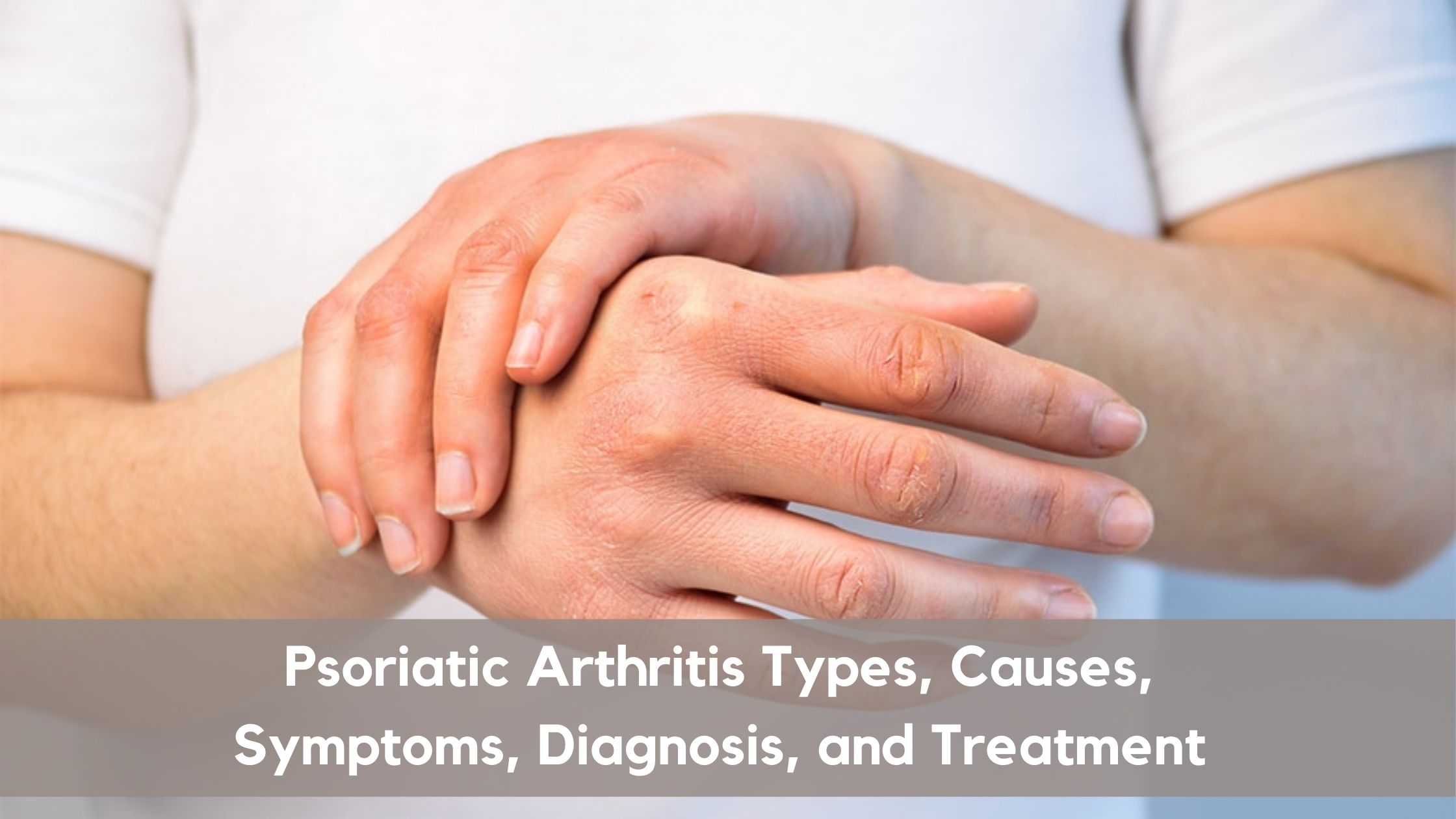

Psoriatic arthritis is a deforming, seronegative, oligoarticular inflammatory arthritis that can involve small or large joints mostly found in patients with a type of autoimmune skin condition called psoriasis.
There are five clinical patterns of psoriatic arthritis.
Oligoarticular arthritis
Asymmetrical inflammatory oligoarthritis affects about 40% of patients and often presents abruptly with a combination of synovitis and adjacent periarticular inflammation. This occurs most characteristically in the hands and feet when synovitis of a finger or toe couples with tenosynovitis(inflammation of tendon sheath where the muscle connects to bone), enthesitis, and inflammation of intervening tissue to give a ‘sausage digit’ or dactylitis, where the whole digit gets inflamed. Large joints, such as the elbow, ankle, and knee may also be affected with either small-scale or large effusions. Psoriatic arthritis feet is one such common presentation with sausage toes, heel pain, pain on the sole of the foot, and toenail changes. It is caused by inflammation of membranes that line the joints, tendons, and connective tissues of the feet.
Symmetrical psoriatic arthritis
Symmetrical polyarthritis occurs in about 25% of cases. It predominates in women and may strongly resemble Rheumatoid Arthritis, with symmetrical involvement of small and large joints in upper and lower limbs. Nodules and other extra-articular RA features are absent, and arthritis is generally less extensive and more benign. Much of the hand deformity often results from tenosynovitis and soft tissue contractures
Classical psoriatic arthritis affecting distal interphalangeal joints
Distal Interphalangeal (DIP) joints arthritis is an unusual but characteristic pattern affecting men more often than women. It targets finger DIP joints and surrounding periarticular tissues, almost invariably with accompanying nail dystrophy.
Arthritis mutilans
Arthritis mutilans is deforming erosive arthritis targeting the fingers and toes that occurs in 5% of Psoriatic Arthritis cases. Prominent cartilage and bone destruction result in marked instability. The encasing skin appears invaginated and ‘telescoped’ (‘main en lorgnette’) and the affected finger can be pulled back to its original length.
Psoriatic spondylitis
Psoriatic arthritis affecting the spine and the joints in the pelvis is called Psoriatic spondylitis. The symptoms for this condition develop between the pelvis and the neck. Patients with this medical condition usually experience pain, inflammation, and stiffness in their neck and lower back. Sacroiliac joints in the pelvis can also be affected by this condition. Over time, the condition may make it more difficult for a person to move their spine. It may occur alone or with any other clinical patterns described above and is typically unilateral or asymmetric in severity
Psoriatic arthritis occurs when the body’s immune system begins to attack healthy cells and tissue. Such an unnatural immune response causes swelling in joints as well as extra production of skin cells. Although unclear, it is likely that a combination of genetic, immunological, and environmental factors play a role in the causation of this condition. People with psoriatic arthritis usually have a family history of either psoriasis or psoriatic arthritis. Researchers have identified few genetic markers that appear to be psoriatic arthritis carriers making this disease hereditary up to an extent. Environmental factors mainly include viral and bacterial infections and trauma which may trigger the development or exacerbation of psoriatic arthritis in people
The onset of psoriasis and arthritis are as follows:
Skin involvement – psoriatic arthritis skin rash
One of the most common psoriatic arthritis symptoms is a rash: thick red skin covered with flaky white patches.
One may notice the following skin lesions in the context of psoriatic arthritis:
In one study, arthritis was noted more frequently in patients with severe skin disease.In patients presenting with an undefined seronegative polyarthritis, looking for psoriases in hidden sites, such as the scalp (where psoriasis frequently is mistaken for dandruff), perineum, intergluteal cleft, and umbilicus is extremely important. The rash may come and go. There can be extended periods where the patient can be rash-free. Certain conditions not limited to but including stress, infections, and injuries, have the capacity to trigger rash outbreaks. The rash typically develops on the Elbows, Knees, scalp, lower back, genitals, around the belly button, and between the buttocks
Nail involvement
Nails anomalies are involved in 80% of patients with psoriatic arthritis. Some of the common anomalies are
Extra-articular manifestations
Eye involvement, either conjunctivitis or uveitis, is reported in 7-33% of patients. The uveitis is more often bilateral, chronic, and posterior.
We can find Aortic valve insufficiency in <4% of patients after a long-standing disease.
Risk factors for psoriatic arthritis:
1) Family history of psoriatic arthritis
2) Psoriasis
3) Genetics
4) Age
5) Obesity
6) Smoking
7) Environmental causes
The Classification Criteria for Psoriatic Arthritis (CASPAR) consist of established inflammatory articular disease with at least 3 points from the following features:
A qualified physician decides the line of treatment based on the manifestation and severity of the disease. Treatment may include medical, surgical, and physical therapies. Medical treatment regimens include the use of
In patients with severe skin inflammation, medications such as methotrexate, retinoic-acid derivatives, and psoralen plus ultraviolet (UV) light are considered. These agents have been shown to work on skin and joint manifestations. Intra-articular injection of entheses or single inflamed joints with corticosteroids may be particularly effective in some patient
Surgical care
Physical therapy
The rehabilitation treatment program should be tailor-made for psoriatic arthritis patients and should commence early in the disease. Physical Therapy should account for:
The general measure for a comfortable living for people affected by psoriatic arthritis should include,
With proper lifestyle changes, psoriatic arthritis can be controlled and treated effectively if they can consult the doctor in time. Reach out to VIMS experts who can guide you to maintain a healthy lifestyle and find the best possible treatment for your condition.

 Emergency Number
Emergency Number